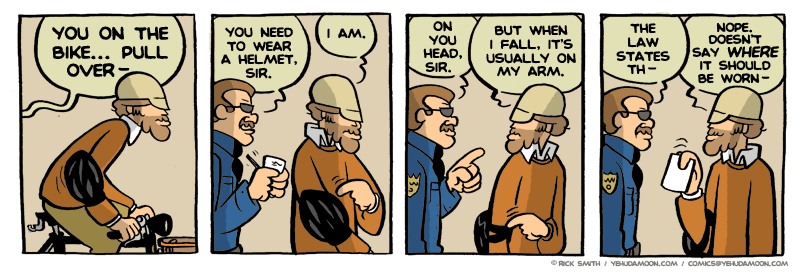In our earlier legal articles we considered what counts as a cycle and where you can legally bike. Now let’s look at what you can and can’t have on your bike (well you can take it from the earlier discussion that you can’t have a petrol motor for starters…).
{The usual disclaimers; not a lawyer, blah, blah, seek proper legal advice when necessary…}
Firstly there are a few things that you must have on your bike; generally all sensible stuff:
- A red or yellow rear reflector that is visible from a distance of 100 metres when light shines on it.
- Good brakes on the front and back wheels; these can be any effective type such as calipers, discs, back-pedal hub, etc (pre-1988 bikes only need a back wheel brake).
- A few additional features like lights and reflectors, if riding at night or in poor visibility (e.g. fog); discussed further later
You can argue the merits or otherwise of this law, but the one thing you need on your person when riding is a securely fastened approved bike helmet (that could include a full-face competitive riding helmet, but something like a rock-climbing helmet or construction hardhat typically doesn’t count). Note that people carried by bike (e.g. children in trailers) also need to wear a helmet. It is possible to seek a written exemption from NZ Transport Agency for having to wear a safety helmet, on the grounds of religious belief, physical disability or other reasonable reasons. Interestingly, the current law is silent on the specifics about actually securely fastening your helmet on your head, but I don’t know if you want to try that line of argument with your local cop…

When cycling at night or when visibility is poor (and we can get some pretty decent fog in Chch…), your bike must also have the following items:
- One or more steady or flashing rear-facing red lights that can be seen at night from a distance of 100 metres (NB: soon proposed to be 200m).
- One or two white or yellow front headlights that can be seen at night from a distance of 100 metres. Only one of these headlights may flash.
- Pedal retro-reflectors on the front and back ends of each pedal; alternatively, you need to wear some reflective material (other than this situation, there is no other mandatory requirement to wear high-visibility clothing when cycling, although it can’t hurt sometimes…).
What about other kinds of lighting, like head-mounted lights, wheel-mounted pattern lights, and pedal lights? As we’ve mentioned before, many of these things actually fall foul of the Vehicle Lighting Rule, which doesn’t allow side-facing lights or any lights that “dazzle, confuse or distract other drivers or other road users.” I’m particularly wary of some of the ultra-bright bike lights now available, especially head-mounted ones. As it stands, the vehicle lighting rules are not well set up to cater for cycle lighting, and actual practice by people out on the street tends to be ahead of what the current law allows (e.g. people were using flashing lights and two headlights long before they were made legal here).
That covers what you must have on your bike; what are the things that are optional to have on a bike? The list includes many useful items, like:

- mudguards
- carriers, with or without panniers
- locks, either attached to the bike or carried separately
- bell or horn to warn other path users
- clip-in pedals for use with shoes with cleats, or pedals fitted with toe straps
- side and front reflectors (front reflectors cannot be red)
- safety flags or those handy “Space-maker” side flags
- rear-view mirrors
- kick stands
- training wheels
- and if you’re really feeling keen, you can throw in a holder for your water bottle, coffee cup, wine bottle or even beers!
You can also have a trailer attached to your bike, but you can’t tow or be towed by another vehicle. That same rule would also seem to technically prevent you from holding one bike while riding another…
Can you “dub” (i.e. carry) someone on a bike? Sadly, no, not unless there is a seat specifically designed for them (which typically restricts most people to carrying small kids only unless you have a cargo bike).

If you are carrying large items on your bike remember that, under the Rules, your load can only extend up to 0.5m out each side and up to 1.0m out each end of your bike. Then you might be able to get away with carrying this…
Finally, it’s important to appreciate that while many of these requirements are described in the NZ Road Code and Code for Cyclists, these are only a summary of the actual legislation (such as the Road User Rule, Vehicle Dimensions & Mass Rule, and Vehicle Lighting Rule). There are little nuances that haven’t been fully captured in the Road Code interpretation so, if in doubt, check the underlying Rules.
Do you have any questions about cycling law in NZ? Let us know!


Interesting that bells are optional. I thought they were mandatory as bikes are always sold with them.
Bells are cheap bike accessories – worth a couple of dollars retail. So its an inexpensive extra for the bike shop to add. I’ve never seen a drop-bar road bike with a bell.